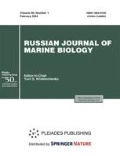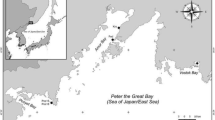Abstract
The genetic diversity of the sea cucumber Apostichopus japonicus was assessed using five microsatellite markers. A total of 122 specimens of sea cucumber from five samples collected in Peter the Great Bay (Sea of Japan) were examined. All loci were polymorphic. For all samples and loci, the average value of the observed heterozygosity was 0.461 ± 0.027 and the expected heterozygosity was 0.575 ± 0.031. The values of the inbreeding coefficient were, on average, greater than zero due to the deficiency of heterozygotes. Null alleles were identified for some microsatellite loci. After their detection, genotyping errors and statistical data were corrected. The presence of null alleles caused a 1.5–2-fold decrease in the value of observed heterozygosity and led to deviations from the Hardy–Weinberg equilibrium.

Similar content being viewed by others
REFERENCES
Gavrilova, G.S., Tovarnoe vyrashchivaniye dal’nevostochnogo trepanga (Commercial Culture of Japanese Sea Cucumber), Vladivostok: TINRO-Center, 2013.
Galinskaya, T.V., Schepetov, D.M., and Lysenkov, S.N., Prejudices about microsatellite research and how to resist them, Russ. J. Genet., 2019, vol. 55, no. 6, pp. 657–671. https://doi.org/10.1134/S1022795419060048
Lysenko, V.N., Zharikov, V.V., and Lebedev, A.M., The abundance and distribution of the Japanese sea cucumber, Apostichopus japonicus (Selenka, 1867) (Echinodermata: Stichopodidae), in nearshore waters of the southern part of the Far Eastern State Marine Reserve, Russ. J. Mar. Biol., 2015, vol. 41, no. 2, pp. 140–144. https://doi.org/10.1134/S1063074015020078
Lysenko, V.N., Zharikov, V.V., and Lebedev, A.M., The current status of populations of the sea cucumber Apostichopus japonicus (Selenka, 1867) in the Far Eastern Marine Reserve, Russ. J. Mar. Biol., 2018, vol. 44, pp. 164–171. https://doi.org/10.1134/S1063074018020074
Selin, N.I., Vertical distribution of the Far East trepang Apostichopus japonicus in Vostok Bay, Sea of Japan, Russ. J. Mar. Biol., 2001, vol. 27, no. 4, pp. 256–258. https://doi.org/10.1023/A:1011971504890
Abdul-Muneer, P.M., Application of microsatellite markers in conservation and fisheries management: Recent advances in population structure analysis and conservation strategies, Genet. Res. Int., 2014, vol. 2014, 691759. https://www.ncbi.nlm.nih.gov/pmc/articles/PMC3997932. https://doi.org/10.1155/2014/691759
An, H.S., Lee, J.W., Hong, S.W., et al., Genetic differences between wild and hatchery populations of red sea cucumber (Stichopus japonicus) inferred from microsatellite markers: Implications for production and stocking programs design, Genes Genomics, 2013, vol. 35, pp. 709–717. https://doi.org/10.1007/s13258-013-0139-8
Arthofer, W., Heussler, C., Krapf, P., et al., Identifying the minimum number of microsatellite loci needed to assess population genetic structure: A case study in fly culturing, Fly, 2018, vol. 12, no. 1, pp. 13–22. https://doi.org/10.1080/19336934.2017.1396400
Brookfield, J.F.Y., A simple new method for estimating null allele frequency from heterozygote deficiency, Mol. Ecol., 1996, vol. 5, no. 3, pp. 453−455. https://doi.org/10.1111/j.1365-294X.1996.tb00336.x
Carlsson, J., Effects of microsatellite null alleles on assignment testing, J. Hered., 2008, vol. 99, no. 6, pp. 616–623. https://doi.org/10.1093/jhered/esn048
Chakraborty, R., de Andrade, M., Daiger, S.P., and Budowle, B., Apparent heterozygote deficiencies observed in DNA typing data and their implications in forensic applications, Ann. Hum. Genet., 1992, vol. 56, no. 1, pp. 45–57. https://doi.org/10.1111/j.1469-1809.1992.tb01128.x
Chang, Y., Feng, Z., Yu, J., and Ding, J., Genetic variability analysis in five populations of the sea cucumber Stichopus (Apostichopus) japonicus from China, Russia, South Korea and Japan as revealed by microsatellite markers, Mar. Ecol., 2009, vol. 30, no. 4, pp. 455–461. https://doi.org/10.1111/j.1439-0485.2009.00292.x
Chapuis, M.-P. and Estoup, A., Microsatellite null alleles and estimation of population differentiation, Mol. Biol. Evol., 2007, vol. 24, no. 3, pp. 621–631. https://doi.org/10.1093/molbev/msl191
Chen, L., Li, Q., and Yang, J., Microsatellite genetic variation in wild and hatchery populations of the sea cucumber (Apostichopus japonicus Selenka) from northern China, Aquacult. Res., 2008, vol. 39, no. 14, pp. 1541–1549. https://doi.org/10.1111/j.1365-2109.2008.02027.x
Chen, M., Gao, L., Zhang, W., et al., Identification of forty-five gene-derived polymorphic microsatellite loci for the sea cucumber, Apostichopus japonicus, J. Genet., 2013, vol. 92, no. 2, p. e31–35. http://www.ias.as.in/jgenet/OnlineResources/92/e31.pdf. https://doi.org/10.1007/s12041-013-0234-2
Chybicki, I. and Burczyk, J., Simultaneous estimation of null alleles and inbreeding coefficients, J. Hered., 2009, vol. 100, no. 1, pp. 106–113. https://doi.org/10.1093/jhered/esn088
Dąbrowski, M.J., Bornelöv, S., Kruczyk, M., et al. ‘True’ null allele detection in microsatellite loci: A comparison of methods, assessment of difficulties and survey of possible improvements, Mol. Ecol. Resour., 2015, vol. 15, no. 3, pp. 477–488.https://doi.org/10.1111/1755-0998.12326
Dakin, E.E. and Avise, J.C., Microsatellite null alleles in parentage analysis, Heredity, 2004, vol. 93, no. 5, pp. 504–509. https://doi.org/10.1038/sj.hdy.6800545
De Meeûs, T., Revisiting FIS, FST, Wahlund effects, and null alleles, J. Hered., 2018, vol. 109, no. 4, pp. 446–456. https://doi.org/10.1093/jhered/esx106
Dempster, A.P., Laird, N.M., and Rubin, D.B., Maximum likelihood from incomplete data via the EM algorithm, J. R. Stat. Soc., Ser. B, 1977, vol. 39, no. 1, pp. 1–38. https://doi.org/10.1111/j.2517-6161.1977.tb01600.x
Dong, Y., Li, Q., Zhong, X., and Kong, L., Development of gene-derived SNP markers and their application for the assessment of genetic diversity in wild and cultured populations in sea cucumber, Apostichopus japonicus, J. World Aquacult. Soc., 2016, vol. 47, no. 6, pp. 873–888. https://doi.org/10.1007/s12686-013-9858-z
Du, H., Bao, Z., Yan, J., et al., Development of 101 gene-based single nucleotide polymorphism markers in sea cucumber, Apostichopus japonicus, Int. J. Mol. Sci., 2012, vol. 13, no. 6, pp. 7080–7097. https://doi.org/10.3390/ijms13067080
Ellegren, H., Microsatellites: Simple sequences with complex evolution, Nat. Rev. Genet., 2004, vol. 5, pp. 435–445. https://doi.org/10.1038/nrg1348
Excoffier, L. and Lischer, H.E.L., Arlequin suite ver 3.5: A new series of programs to perform population genetics analyses under Linux and Windows, Mol. Ecol. Resour., 2010, vol. 10, no. 3, pp. 564–567. https://doi.org/10.1111/j.1755-0998.2010.02847.x
Girard, P., A robust statistical method to detect null alleles in microsatellite and SNP datasets in both panmictic and inbred populations, Stat. Appl. Genet. Mol. Biol., 2011, vol. 10, p. 9. https://pubmed.ncbi.nlm.nih.gov/21381434/. https://doi.org/10.2202/1544-6115.1620
Girard, P. and Angers, B., Assessment of power and accuracy of methods for detection and frequency-estimation of null alleles, Genetica, 2008, vol. 134, no. 2, pp. 187–197. https://doi.org/10.1007/s10709-007-9224-8
Grimaldi, M.-C. and Crouau-Roy, B., Microsatellite allelic homoplasy due to variable flanking sequences, J. Mol. Evol., 1997, vol. 44, pp. 336–340. https://doi.org/10.1007/PL00006151
Huang, K., Ritland, K., Dunn, D.W., et al., Estimating relatedness in the presence of null alleles, Genetics, 2016, vol. 202, no. 1, pp. 247–260. https://doi.org/10.1534/genetics.114.163956
Kalinowski, S.T. and Taper, M.L., Maximum likelihood estimation of the frequency of null alleles at microsatellite loci, Conserv. Genet., 2006, vol. 7, pp. 991–995. https://doi.org/10.1007/s10592-006-9134-9
Kanno, M., Suyama, Y., Li Q., and Kijima, A., Microsatellite analysis of Japanese sea cucumber, Stichopus (Apostichopus) japonicus, supports reproductive isolation in color variants, Mar. Biotechnol., 2006, vol. 8, pp. 672–685. https://doi.org/10.1007/s10126-006-6014-8
Kim, M., Choi, T., and An, H.S., Population genetic structure of sea cucumber, Stichopus japonicus in Korea using microsatellite markers, Aquacult. Res., 2008, vol. 39, no. 10, pp. 1038–1045. https://doi.org/10.1111/j.1365-2109.2008.01962.x
Kolodziej, K., Theissinger, K., Brün, J., et al., Determination of the minimum number of microsatellite markers for individual genotyping in wild boar (Sus scrofa) using a test with close relatives, Eur. J. Wildl. Res., 2012, vol. 58, pp. 621–628. https://doi.org/10.1007/s10344-011-0588-9
Lemer, S., Rochel, E., and Planes, S., Correction method for null alleles in species with variable microsatellite flanking regions, a case study of the black-lipped pearl oyster Pinctada margaritifera, J. Hered., 2011, vol. 102, no. 2, pp. 243–246. https://doi.org/10.1093/jhered/esq123
Oh, G.-W., Ko, S.-C., Lee, D.H., et al., Biological activities and biomedical potential of sea cucumber (Stichopus japonicus): A review, Fish. Aquat. Sci., 2017, vol. 20, p. 28. https://doi.org/10.1186/s41240-017-0071-y
Peakall, R. and Smouse, P.E., GenAlEx 6.5: Genetic analysis in Exel. Population genetic software for teaching and research—an update, Bioinformatics, 2012, vol. 28, no. 19, pp. 2537–2539. https://doi.org/10.1093/bioinformatics/bts460
Rico, C., Cuesta, J.A., Drake, P., et al., Null alleles are ubiquitous at microsatellite loci in the Wedge Clam (Donax trunculus), PeerJ., 2017, vol. 5, e3188. https://peerj.com/articles/3188/. https://doi.org/10.7717/peerj.3188
Selenka, E., Beiträge zur Anatomie und Systematik der Holothurien, Z. Wiss. Zool., 1867, vol. 17, pp. 291–374.
Soliman, T., Kanno, M., Kijima, A., and Yamazaki, Y., Population genetic structure and gene flow in the Japanese sea cucumber Apostichopus japonicus across Toyama Bay, Japan, Fish. Sci., 2012, vol. 78, pp. 775–783. https://doi.org/10.1007/s12562-012-0509-1
Truett, G.E., Preparation of genomic DNA from animal tissues, in DNA Sequencing II: Optimizing Preparation and Cleanup, Boston: Jones and Bartlett, 2006, chapter 3, pp. 33–46.
Van Oosterhout, C., Hutchinson, W.F., Wills, D.P.M., and Shipley, P., MICRO-CHECKER: Software for identifying and correcting genotyping errors in microsatellite data, Mol. Ecol. Notes, 2004, vol. 4, no. 3, pp. 535–538. https://doi.org/10.1111/j.1471-8286.2004.00684.x
ACKNOWLEDGMENTS
The authors are grateful to E.I. Bondar (Zhirmunsky National Scientific Center of Marine Biology, Far Eastern Branch, Russian Academy of Sciences), I. Chybicki (Casimir the Great University, Poland), and M.J. Dąbrowski (Museum and Institute of Zoology of the Polish Academy of Sciences) for help in research.
Author information
Authors and Affiliations
Corresponding author
Ethics declarations
Conflict of interest. The authors declare that they have no conflicts of interest.
Statement on the welfare of animals. All applicable international, national, and/or institutional guidelines for the care and use of animals were followed.
Additional information
Translated by T. Koznova
APPENDIX
APPENDIX
Rights and permissions
About this article
Cite this article
Yagodina, V.D., Batishcheva, N.M. & Brykov, V.A. Variation at Nuclear Loci in the Japanese Sea Cucumber Apostichopus japonicus (Selenka, 1867) (Echinodermata: Holothuroidea) in Samples from Peter the Great Bay, Sea of Japan. Russ J Mar Biol 48, 380–388 (2022). https://doi.org/10.1134/S1063074022050212
Received:
Revised:
Accepted:
Published:
Issue Date:
DOI: https://doi.org/10.1134/S1063074022050212



